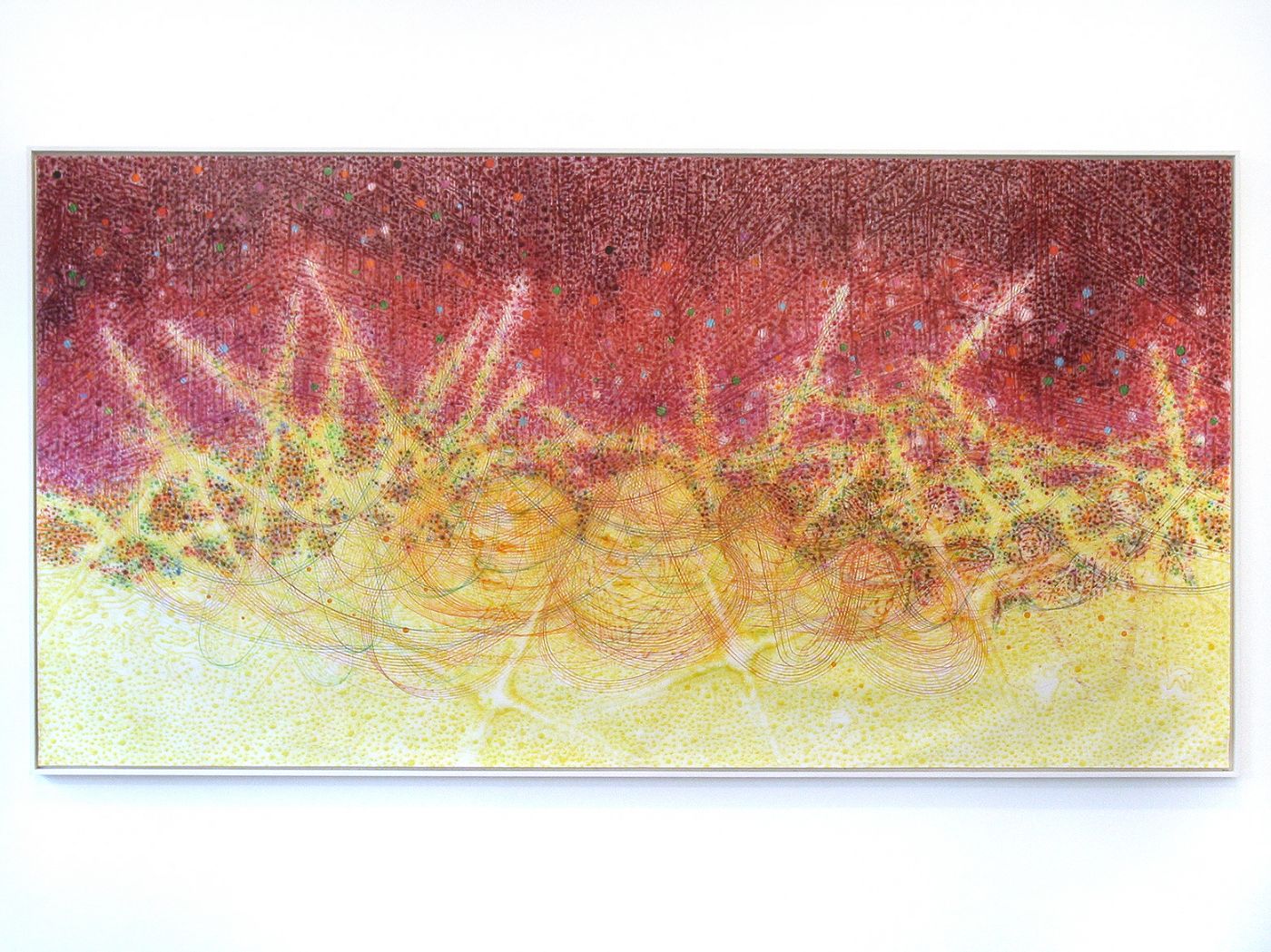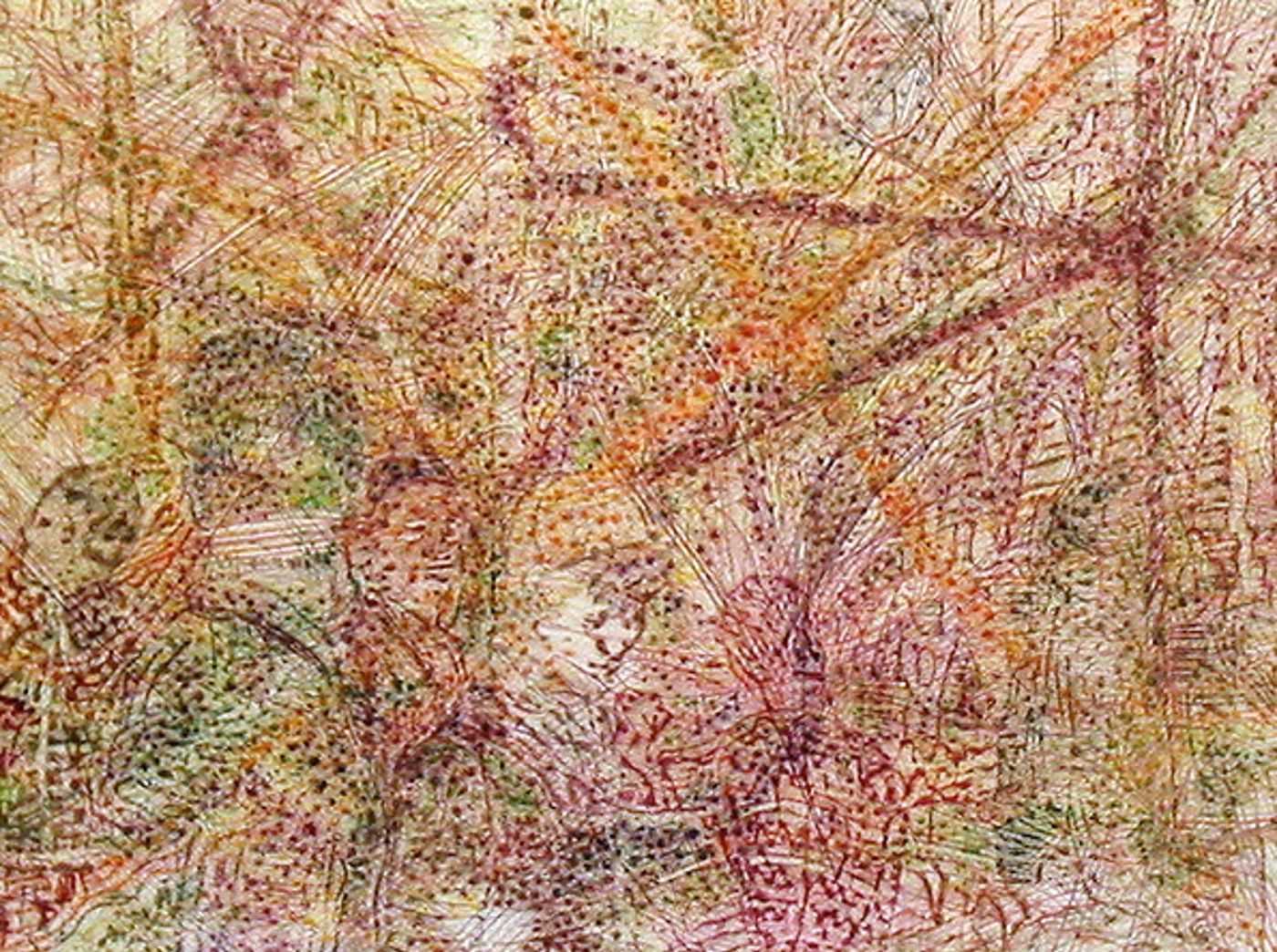On the Two Corners2005
Frehrking Wiesehöfer, Cologne
29 October to 22 December
Somewhere in Between
Somewhere in between
The waxing and the waning wave
Somewhere in between
What the song and silence say
Somewhere in between
The ticking and the tocking clock
Somewhere in a dream between
Sleep and waking up
Some ... more
On the Two Corners2005
Frehrking Wiesehöfer, Cologne
29 October to 22 December
Somewhere in Between
Somewhere in between
The waxing and the waning wave
Somewhere in between
What the song and silence say
Somewhere in between
The ticking and the tocking clock
Somewhere in a dream between
Sleep and waking up
Somewhere in between
Breathing out and breathing in
Like twilight is neither night nor morning
Kate Bush
The world as matrix. It is scarcely visible, only certain particulars are recognisable. It wants to shine through, emerges in parts, only to be overrun by colours and their structures. The Aristotelian horror vacui takes its course, becoming more intimidating from image to image, threatening to swallow the empty space, even more, the world that is being submerged beneath it. Until we no longer know what was there first: Were they not the same structures and textures that allowed this world to emerge as a matrix in the first place, only to then destroy it in the same breath? So what do we actually see and recognise? What? An image that may have been the basis for this matrix? A hollow shape between banked contours? Peeled out and then scarred to the point of being unrecognisable? That may well be – but that would be too coarse, too violent, would not really do justice to the real character of these frottages. For these images are really poetic, visually rich, expressive, atmospheric. So what then?
This is the kind of, partly rational, partly emotional, perplexity that assails us when confronted with Anna Amadio's most recent group of works. While thinking tries to master this opulent pictorial world through language, a vague feeling always seems to come to light just when language fails. The identification and deciphering of apparently familiar motifs is undermined by powerful textures which we merely see, without being able to grasp them iconically or conceptually. Yet secretly there are two ways of encountering Anna Amadio's drawings: The first is to try and follow the artist's approach in terms of the working process, as it were, genotypically – then you would start with a photograph that constitutes the model (Vorbild) for those frottages which are gradually worked out from under a gestural drawing and then covered over again. The second way is to confront these drawings directly, meaning with a mode of seeing that – this time phenotypically – works through the colourful clods, craters and crevasses layer by layer, penetrating here and there to the beginning of the work. While the first way enables a kind of logical (i.e. linguistic) understanding that cannot yet explain everything, the second way takes us into those realms in Anna Amadio's work that eschew language. Or as Claudio Moser puts it in a Letter to Anna: to that point where "the eye meanders" and the vocabulary allows "stories of its own to emerge", falteringly, or "stutteringly".
If one initially focuses on asking how that which can be seen came about, then at least a clue can be found in the title of the six-part work group: On the Two Corners is the name Anna Amadio has chosen for these large-format works on paper which she produced in 2005. They are based on photographs of two blocks of houses in New York which form the fundamental structure, so to speak, of all the works in this group. As if viewed from an extreme wide-angle perspective, the two multi-storied corner houses shift into the background, between them is a street that tapers towards the centre ground. Here and there different figures crop up: the profile of a man, the shadow of a passer-by, the sole of whose shoe is the only thing that is really recognisable. The structure of the house facade is mirrored on the ground. One image further on, this ground seems to be coarse asphalt. And so, using clichés from "real" life, Anna Amadio composes a set of motifs which she not only repeats, but also deliberately modifies within the work group.
The decisive point is how this "reality" makes its way into the drawings: First, this reality leaves a physical trace behind on a photograph – the light draws on the light-sensitive material. The resulting photographs then become the model for that distemper drawing on which the frottage emerges. Basically, the motif of the drawing is based on a dual indexical sign relationship which in both cases results in a physical representation. Yet the degree of alienation and estrangement to which the motif is subjected during this process could not be greater or more forceful. For whereas the transfer of "reality" from the photograph to the distemper drawing still shows real features, the physical representation in the frottage gradually develops into a phantasmagoria. Max Ernst – the forefather, as it were, of the modern frottage – had already recognised this in the 1920s and been able to use it for his art, an art which Paul Eluard describes as "donner a voir" (giving to see). Yet where Ernst deliberately worked motifs out of the found textures, Anna Amadio proceeds in the opposite direction: she rubs the underlying motif so long until it becomes smoothly and equivalently incorporated into the structure of the drawing.
This impression is confirmed when you take the second, phenotypical, approach to Anna Amadio's drawings, that is to say, directly through seeing. On the Two Corners #1 is enclosed by the surface of the white paper on which the lines of the house facades are clearly visible. The street running between them is meanwhile the setting for unreal scenes: the people standing there and the passers-by are enmeshed in nets and fountains, a wave ornament on the left of the image prevents us from recognising whether this is due to the distemper drawing model or the drawing itself. In image #2, the scene of the event seems to have cleared for a moment; like swarms of insects, two cloud forms veil the people and the passers-by on the street. In image #3, details of the block of houses on the right – brickwork, supports, props, balustrades and a gate – come into view, while the spatial link with the opposite street corner is almost totally cut off. All we see here are vague chimeras covered in green scars, their shapes and relative sizes no longer clearly identifiable.
It is from here that the above mentioned horror vacui takes its inexorable course – but it is neither an end in itself, nor is it due to the associated anxiety in the face of emptiness. There is actually a totally different reason for Anna Amadio's image-filling energy: she seems to have deliberately opted for the freedom of the phantasmagorical drawing and against the restrictions of representation. Under the dense meshes of colour and large areas of hatching in image #4, the house facades merge on a glowing red horizon, bundled rays of light cross their trajectory, and small explosions of colour enliven the starry sky. In image #5, the pictorial space is populated by biomorphic and floral signs whose density and opulence are surpassed in #6, where the motif, though almost complete, hovers once again between the recognisable Two Corners and that image-filling texture which we would still like to read as a mere sign. Only in the final image of this work group does this shimmering fata morgana again become a cloud – before finally evaporating and slowly disappearing out of the pictorial space.
Whichever one of the two paths you take to the works of Anna Amadio – ultimately, the inner borderlines which the artist explores in her drawings prevent a synthesis of the antagonistic forces: the positivist attempt to arrive at a dual indexical pictorial solution asserts itself in a variant of the drawing that is simply itself – or pure phantasmagoria. The foreground, or better underground, "reality" which Amadio transfers into the image only becomes visible through the frottage and is then successively destroyed by means of sweeping gestures. The iconic sign, that still saves a mere residue of this "reality" in the image, is soaked for so long in ciphers and textures until their own unreal reality dominates the whole vocabulary of the image.
It is not longer possible to determine just where these borderlines run in Anna Amadio's works – whether you start at the beginning or the end of these images. What they do indicate is a state of "somewhere in-between", from where the artist does not force a mere compromise on the disjunctive nebeneinander and nacheinander of her images, but instead generates a marvellous tension: between the waxing and the waning wave, between the ticking and the tocking clock, between sleep and waking up, between breathing out and in. One of the most compelling qualities of Anna Amadio's work is to have created for these tense moments a lasting, expressive and evocative poetry.
Text Ralf Christofori
Photos Gallery Frehrking Wiesehöfer, Cologne

On the Two Corners |2005 |Frottage, Farbstift auf Papier

On the Two Corners |2005 |Frottage, Farbstift auf Papier

On the Two Corners, Nummer 2 |2005 |Frottage, Farbstift auf Papier |152 x 298 cm [H W D]

On the Two Corners |2005 |Frottage, Farbstift auf Papier

On the Two Corners, Nummer 4 |2005 |Frottage, Farbstift auf Papier |152 x 298 cm [H W D]

On the Two Corners, Detail, Nummer 1 |2005 |Frottage, Farbstift auf Papier |152 x 298 cm [H W D]

On the Two Corners |2005 |Frottage, Farbstift auf Papier

On the Two Corners |2005 |Frottage, Farbstift auf Papier

On the Two Corners, Nummer 5 |2005 |Frottage, Farbstift auf Papier |152 x 298 cm [H W D]









